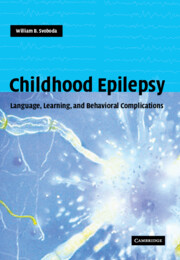Book contents
- Frontmatter
- Contents
- Preface
- Glossary
- 1 Looking ahead
- Part I Speech and language problems
- 2 Language: the challenge
- 3 Speech, language, and communication
- 4 Speech and language problems in epilepsy
- 5 Seizure types and speech and language risks
- 6 Language regression with epilepsy syndromes
- 7 Other epilepsy language syndromes
- 8 Seizure-management effects
- 9 Evaluation of speech and language problems
- 10 Management of speech and language problems in epilepsy
- 11 Behavior consequences
- Part II Learning problems
- Part III Behavior problems
- Index
- References
6 - Language regression with epilepsy syndromes
from Part I - Speech and language problems
Published online by Cambridge University Press: 26 October 2009
- Frontmatter
- Contents
- Preface
- Glossary
- 1 Looking ahead
- Part I Speech and language problems
- 2 Language: the challenge
- 3 Speech, language, and communication
- 4 Speech and language problems in epilepsy
- 5 Seizure types and speech and language risks
- 6 Language regression with epilepsy syndromes
- 7 Other epilepsy language syndromes
- 8 Seizure-management effects
- 9 Evaluation of speech and language problems
- 10 Management of speech and language problems in epilepsy
- 11 Behavior consequences
- Part II Learning problems
- Part III Behavior problems
- Index
- References
Summary
The acquired aphasias (or agnosias) with or without epilepsy are a group of disorders in children presenting in the first decade of life with the loss of understanding, followed by the loss of expression of language with some depression of intelligence. Behavior problems emerge. In a number of such children, seizures may emerge or the EEG may become abnormal, especially at night in slow sleep. The seizures are controllable with medication, but the language deficit continues, although partial recovery is seen in adolescence. The Landau–Kleffner syndrome (LKS) is the primary model of acquired aphasia with epilepsy, but there are other similar syndromes that are possibly related if not variants of the same basic disorders. Treatment is controversial. The cause is unknown.
Landau–Kleffner syndrome
LKS of acquired aphasia with epilepsy is a childhood syndrome that occurs in previously normal children. This is a triad consisting of a loss of language functions, the usual emergence of a variety of seizures with EEG abnormalities in the temporal-parietal-occipital areas, and a resultant deterioration of behavior. The condition stabilizes for years and then, often in adolescence, begins to recover (Ballaban-Gil & Tuchman, 2000).
LKS has aslo been called the acquired childhood aphasia (or agnosia) with epilepsy syndrome and the acquired aphasia and epileptiform EEG syndrome (Roger et al., 1985). It is related to, if not the same as, such entities as continuous spike-wave status in sleep, epileptic status epilepticus in sleeps, and similar syndromes. These may be variants of a common insult.
- Type
- Chapter
- Information
- Childhood EpilepsyLanguage, Learning and Behavioural Complications, pp. 70 - 100Publisher: Cambridge University PressPrint publication year: 2004



